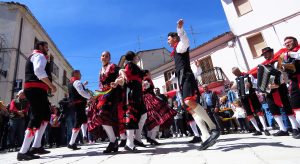
When it comes to dance, Italy is a country that has a rich and diverse cultural heritage. From the traditional folk dances of the countryside to the elegant ballroom dances of the cities, Italian dance is a celebration of life, passion, and romance.
One of the most iconic dances of Italy is the Tarantella. This fast-paced, lively dance is said to have originated in the southern region of Apulia, where it was traditionally performed to cure the bite of a tarantula spider. Legend has it that the bite of the spider would cause a fever and convulsions, which could only be cured by dancing to the rhythm of the Tarantella. Today, the Tarantella is performed at weddings, festivals, and other celebrations, and its energetic steps and twirls are a symbol of joy and happiness.
Another popular dance in Italy is the Tammurriata, which comes from the region of Campania, in southern Italy. This dance is characterized by the use of the tammorra, a large drum that is played with sticks or hands. The rhythms of the tammorra are accompanied by singing and dancing, creating a festive and lively atmosphere. The Tammurriata is often performed during the Feast of St. Anthony, a religious festival that takes place in Naples every year.
In the north of Italy, the waltz is a popular dance that is often associated with the elegant ballrooms of Venice and Milan. The waltz was introduced to Italy in the early 19th century and quickly became a favorite among the upper classes. Its graceful movements and romantic melodies have made it a timeless classic, and it is still danced today at formal events and dance competitions.
One of the most unique dances in Italy is the Pizzica. This traditional dance comes from the Salento region, in the heel of the Italian boot, and it is said to have originated as a way to cure the bite of a tarantula spider, much like the Tarantella. The Pizzica is a fast and frenzied dance that is performed to the rhythm of the tamburello, a small drum, and the accordion. Its lively steps and fast-paced rhythms are a testament to the energy and passion of the people of Salento.
Italian dance is not only rich in history and tradition, but it is also a reflection of the country’s diverse cultural heritage. Italy has been influenced by many different cultures over the centuries, and this is reflected in its dance styles. For example, the Mazurka, a dance that originated in Poland, became popular in Italy in the 19th century and is still danced today. Similarly, the Tango, a dance that originated in Argentina, was introduced to Italy in the early 20th century and quickly became a favorite among the country’s dance enthusiasts.
In addition to its traditional dances, Italy is also home to a thriving contemporary dance scene. Italian choreographers and dancers are known for their creativity and innovation, and they have made a significant impact on the world of dance. From the avant-garde works of Pina Bausch to the contemporary ballets of Mauro Bigonzetti, Italian dance is a vibrant and exciting art form that continues to evolve and inspire.
In conclusion, Italian dance is a celebration of life, passion, and romance. Its rich and diverse cultural heritage is reflected in its many different styles and rhythms, and its timeless classics are still danced and enjoyed today. Whether it is the energetic steps of the Tarantella, the festive rhythms of the Tammurriata, or the elegant movements of the waltz, Italian dance is a testament to the beauty and artistry of human expression.

Trivia: Did you know that the Tarantella was also believed to have originated as a dance to ward off the effects of the bite of the wolf spider, not just the tarantula? The word “tarantella” actually comes from the Italian town of Taranto, which was believed to have a high population of tarantula spiders.
The dance was originally performed as a form of therapy or exorcism to help the person bitten by the spider to expel the poison from their body. The dance was performed until the person collapsed from exhaustion, which was believed to be a sign that the poison had been expelled. Today, the Tarantella is still performed as a celebration of life and love, rather than as a form of healing.
In addition to the Tarantella, other traditional dances of Italy also have interesting origins and meanings. For example, the Pizzica, which is also believed to have originated as a dance to cure the bite of the tarantula spider, was also thought to be a way for women to express their desire for freedom and independence in a patriarchal society. The Tammurriata, on the other hand, was originally a ritual dance performed by women to invoke the fertility goddess, and it is still performed today as a celebration of life and nature.
Italian dance is not just about the steps and rhythms, but also about the history, culture, and traditions that are passed down from generation to generation. It is a reflection of the Italian way of life, which values passion, romance, and the joy of living. Whether you are a professional dancer or a casual enthusiast, Italian dance has something to offer everyone, and it is sure to leave you with unforgettable memories of the beauty and artistry of this timeless art form.
